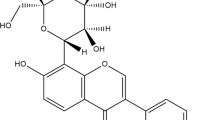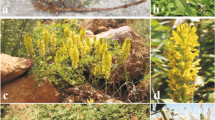Abstract
Alzheimer’s disease (AD) is a progressive neurodegenerative disorder, and the most predominant cause of dementia in the elderly. Traditionally Anisomeles indica (L.) Kuntze has widely been used as tonic to brain. Our aim is to investigate the cholinesterase inhibitory activities, and antioxidant properties of the plant extracts in the treatment of AD. The crude methanol extract was prepared by cold extraction method and four fractions namely petroleum ether, chloroform, ethyl acetate, and water fraction were assessed for acetylcholinesterase and butyrylcholinesterase inhibitory activity by the Ellman method, and their antioxidant properties were assessed by several assays including reducing power, scavenging of DPPH and hydroxyl radicals together with quantitative analyses of endogenous substances. Among the tested samples, ethyl acetate extract was found to demonstrate the highest inhibitory activity significantly against both acetylcholinesterase and butyrylcholinesterase enzymes with IC50 values of 176.02 and 143.78 mg/ml, respectively. Similarly, ethyl acetate extract exhibited the highest radical scavenging ability appeared to be comparable to the reference standard catechin used in this study. The IC50 values of the extract against DPPH and hydroxyl radical scavenging activity were 12.67 and 18.61 mg/ml respectively. Quantitative analyses displayed higher contents of phenolics and flavonoids (79.55 and 347.19 mg gallic acid equivalent/g dried extract respectively) in the ethyl acetate fraction. The results revealed that the ethyl acetate extract, possibly due to its phenolic compounds, exerts potential antioxidant and cholinesterase inhibitory activities which may be useful in the treatment of AD.



Similar content being viewed by others
References
Ademosun AO, Oboh G (2014) Anticholinesterase and antioxidative properties of water-extractable phytochemicals from some citrus peels. J Basic Clin Physiol Pharmacol 25(2):199–204
Agarwal R, Gupta SK, Agarwal P, Srivastava S, Alyayutdin R (2013) Anticholinesterase, antioxidant and nitric oxide scavenging activity of the aqueous extract of some medicinal plants. Br J Pharm Res 3(4):807–816
Ani V, Naidu KA (2011) Antioxidant potential of bitter cumin (Centratherum anthelminticum (L.) Kuntze) seeds in vitro models. BMC Complement Altern Med 11:40
Asaduzzaman M, Uddin MJ, Kader MA, Alam AHMK, Rahman AA, Rashid M, Sadik G (2014) In vitro acetylcholinesterase inhibitory activity and the antioxidant properties of Aegle marmelos leaf extract: implications for the treatment of Alzheimer’s disease. Psychogeriatrics 14(1):1–10
Bonda DJ, Wang X, Perry G (2010) Oxidative stress in Alzheimer disease: a possibility for prevention. Neuropharmacology 59(4):290–294
Choi HY, Jhun EJ, Lim BO (2000) Application of flow injection--chemiluminescence to the study of radical scavenging activity in plants. Phytother Res 14(4):250–253
Dharmasiri MG, Ratnasooriya WD, Thabrew MI (2003) Water extract of leaves and stems of preflowering but not flowering plants of Anisomeles indica possesses analgesic and antihyperalgesic activities in rats. Pharm Biol 41(1):37–44
Elizabeth K, Rao MNA (1990) Oxygen radical scavenging activity of curcumin. Int J Pharm 58(3):237–240
Ellman GL, Courtney KD, Andres V, Feather-stone R (1961) A new and rapid colorimetric determination of acetylcholinesterase activity. Biochem Pharmacol 7(2):88–95
Faria A, Pestana D, Teixeira D, Couraud P, Romero I, Weksler B, de Freitas V, Mateus N, Calhau C (2011) Insights into the putative catechin and epicatechin transport across blood–brain barrier. Food Funct 2(1):39–44
Fawole OA, Amoo SO, Ndhlala AR, Light ME, Finnie JF, Van Staden J (2010) Anti-inflammatory, anticholinesterase, antioxidant and phytochemical properties of medicinal plants used for pain-related ailments in South Africa. J Ethnopharmacol 127(2):235–241
Gülçin I (2010) Antioxidant properties of resveratrol: a structure-activity insight. Innovative Food Sci Emerg Technol 11(1):210–218
Gutierrez-Merino C, Lopez-Sanchez C, Lagoa R, Samhan-Arias K, Bueno C, Garcia-Martinez V (2011) Neuroprotective actions of flavonoids. Curr Med Chem 18(8):1195–1212
Gutzmann H, Hadler D (1998) Sustained efficacy and safety of idebenone in the treatment of Alzheimer’s disease: update on a 2-year double-blind multicentre study. J Neural Transm Suppl 54:301–310
Hsieh SC, Fang SH, Rao YK, Tzeng YM (2008) Inhibition of pro-inflammatory mediators and tumor cell proliferation by Anisomeles indica extracts. J Ethnopharmacol 118(1):65–70
Huang HC, Lien HM, Ke HJ, Chang LL, Chen CC, Chang TM (2012) Antioxidative characteristics of Anisomeles indica extract and inhibitory effect of ovatodiolide on melanogenesis. Int J Mol Sci 13(5):6220–6235
Iqbal K, Wang X, Blanchard J, Liu F, Gong CX, Grundke-Iqbal I (2010) Alzheimer’s disease neurofibrillary degeneration: pivotal and multifactorial. Biochem Soc Trans 38(4):962–966
Janle EM, Lila MA, Grannan M, Wood L, Higgins A, Yousef GG, Rogers RB, Weaver CM (2010) Pharmacokinetics and tissue distribution of 14C-labeled grape polyphenols in the periphery and the central nervous system following oral administration. J Med Food 13(4):926–933
Kudo T, Tanii H, Takeda M (2007) Neurodegerative dementias involving aberrant protein aggregation. Psychogeriatrics 7:114–117
Kumar RS, Rajkapoor B, Perumal P (2012) Antioxidant activities of Indigofera cassioides Rottl. Ex. DC. Using various in vitro assay models. Asian Pac J Trop Biomed 22(4):56–61
Lee SH, Sancheti SA, Bafna MR, Sancheti SS, Seo SY (2011) Acetylcholinesterase inhibitory and antioxidant properties of Rhododendron yedoense var. poukhanense bark. J Med Plant Res 5:248–254
Lyras L, Cairns NJ, Jenner A (1997) An assessment of oxidative damage to proteins, lipids, and DNA in brain from patients with Alzheimer’s disease. J Neurochem 68(5):2061–2069
Massoud F, Gauthier S (2010) Update on the pharmacological treatment of Alzheimer’s disease. Curr Neuropharmacol 8(1):69–80
Masters CL, Selkoe DJ (2012) Biochemistry of amyloid β-protein and amyloid deposits in Alzheimer disease. Cold Spring Harb Perspect Med 2(6):1–24
Mathew M, Subramanian S (2014) In vitro screening for anti-cholinesterase and antioxidant activity of methanolic extracts of ayurvedic medicinal plants used for cognitive disorders. PLoS ONE 9:e86804
Mbaebie BO, Edeoga HO, Afolayan AJ (2012) Phytochemical analysis and antioxidants activities of aqueous stem bark extract of Schotia latifolia Jacq. Asian Pac J Trop Biomed 2(2):118–124
Murakami K, Irie K, Ohigashi H, Hara H, Nagao M, Shimizu T, Shirasawa T (2005) Formation and stabilization model of the 42-mer Aβ radical: implications for the long-lasting oxidative stress in Alzheimer’s disease. J Am Chem Soc 127(43):15168–15174
Neugroschl J, Sano M (2010) Current treatment and recent clinical research in Alzheimer’s disease. Mt Sinai J Med 77(1):3–16
Oboh G, Ademosun AO (2011) Characterization of the antioxidant properties of phenolic extracts from some citrus peels. J Food Sci Technol 49(6):729–736
Oyaizu M (1986) Studies on products of browning reactions: antioxidant activities of products of browning reaction prepared from glucose amine. Jpn J Nutr 44:307–315
Pervin M, Hasnat MA, Lee YM, Kim DH, Jo JE, Lim BO (2014) Antioxidant activity and acetylcholinesterase inhibition of Grape Skin Anthocyanin (GSA). Molecules 19(7):9403–9418
Pietta PG (2000) Flavonoids as antioxidants. J Nat Prod 63(7):1035–1042
Rahman MA, Uddin SB, Wilcock CC (2007) Medicinal plants used by Chakma tribe in Hill Tracts districts of Bangladesh. Indian J Tradit Knowl 6(3):508–517
Rao YK, Fang SH, Hsieh SC, Yeh TH, Tzeng YM (2009) The constituents of Anisomeles indica and their anti-inflammatory activities. J Ethnopharmacol 121(2):292–296
Reed TT, Owen J, Pierce WM, Sebastian A, Sullivan PG, Butterfield DA (2009) Proteomic identification of nitrated brain proteins in traumatic brain-injured rats treated post injury with gammaglutamylcysteine ethyl ester: insights into the role of elevation of glutathione as a potential therapeutic strategy for traumatic brain injury. J Neurosci Res 87(2):408–417
Rice-Evans CA, Miller NJ, Bolwell PG, Bramley PM, Pridham JB (1995) The relative antioxidant activities of plant-derived polyphenolic flavonoids. Free Radic Res 22(4):375–383
Rong T (2010) Chemistry and biochemistry of dietary polyphenol; a review. Nutrients 2(12):1231–1246
Schulz V (2003) Ginkgo extract or cholinesterase inhibitors in patients with dementia: what clinical and guidelines fail to consider. Phytomedicine 10:74–79
Singhal AK, Naithani V, Bangar OP (2012) Medicinal plants with a potential to treat Alzheimer and associated symptoms. Int J Nutr Pharmacol Neurol Dis 2(2):84–91
Singleton VL, Orthofer R, Lamuela-Raventos RM (1999) Analysis of total phenols and other oxidation substrates and antioxidants by means of Folin-Ciocalteu reagent. Methods Enzymol 299(1):152–178
Tabner BJ, Turnbull S, El-Agnaf OMA, Allsop D (2002) Formation of hydrogen peroxide and hydroxyl radicals from Aβ and α-synuclein as a possible mechanism of cell death in Alzheimer’s disease and Parkinson’s disease. Free Radic Biol Med 32(11):1076–1083
Tabner BJ, El-Agnaf OM, Turnbull S, German MJ, Paleologou KE, Hayashi Y, Cooper LJ, Fullwood NJ, Allsop D (2005) Hydrogen peroxide is generated during the very early stages of aggregation of the amyloid peptides implicated in Alzheimer disease and familial British dementia. J Biol Chem 280(43):35789–35792
Tamagno E, Bardini P, Obbili A, Vitali A, Borghi R, Zaccheo D, Pronzato MA, Danni O, Smith MA, Perry G, Tabaton M (2002) Oxidative stress increases expression and activity of BACE in NT2 neurons. Neurobiol Dis 10(3):279–288
Tanaka T, Kazui H, Morihara T, Sadik G, Kudo T, Takeda M (2008) Post marketing survey of donepezil Hydrochloride in Japanese patients with Alzheimer’s disease with behavioral and psychological symptoms of dementia (BPSD). Psychogeriatrics 8(3):114–123
Terry JAV, Buccafusco JJ (2003) The cholinergic hypothesis of age and Alzheimer’s disease- related cognitive deficits: recent challenges and their implications for novel drug development. J Pharmacol Exp Ther 306(3):821–827
Tong Y, Zhou W, Fung V, Christensen MA, Qing H, Sun X, Song W (2005) Oxidative stress potentiates BACE1 gene expression and Aβ generation. J Neural Transm 112(3):455–469
Wang YC, Huang TL (2005) Screening of anti-Helicobacter pylori herbs deriving from Taiwanese folk medicinal plants. FEMS Immunol Med Microbiol 43(2):295–300
Yusuf M, Begum J, Hoque MN, Chowdhury JU (2009) Medicinal plants of Bangladesh. Bangladesh Council of Scientific and Industrial Research, Dhaka-1205, Bangladesh
Zhishen J, Mengcheng T, Jianming W (1999) The determination of flavonoid contents in mulberry and their scavenging effects on superoxide radicals. Food Chem 64(4):555–559
Acknowledgments
We are grateful to the Department of Pharmacy, University of Rajshahi, Bangladesh for providing facilities of this research work.
Author information
Authors and Affiliations
Corresponding author
Ethics declarations
Ethical Statement
Human blood from anonymous healthy men subject was provided by the International Islamic University Medical Center, Chittagong, Bangladesh using a protocol approved by the Institutional Ethics Committee of International Islamic University Chittagong. An earlier consent, approval number ECPDIIUC38/05’13, was taken from the Ethics Committee of Pharmacy Department, International Islamic University Chittagong, Bangladesh for collection of blood. We the authors are very respectful about using the human blood. We did not misuse any drop of valuable human blood.
We sacrificed some rats for the collection of rat brain and used as crude enzyme in this study. We were very careful about animal handling and obeyed all of the protocols in this regards approved by the Institutional Ethics Committee of International Islamic University Chittagong.
Conflict of Interest
The authors declare that they have no conflict of interest.
Rights and permissions
About this article
Cite this article
Uddin, M.J., Abdullah-Al-Mamun, M., Biswas, K. et al. Assessment of anticholinesterase activities and antioxidant potentials of Anisomeles indica relevant to the treatment of Alzheimer’s disease. Orient Pharm Exp Med 16, 113–121 (2016). https://doi.org/10.1007/s13596-016-0224-z
Received:
Accepted:
Published:
Issue Date:
DOI: https://doi.org/10.1007/s13596-016-0224-z




